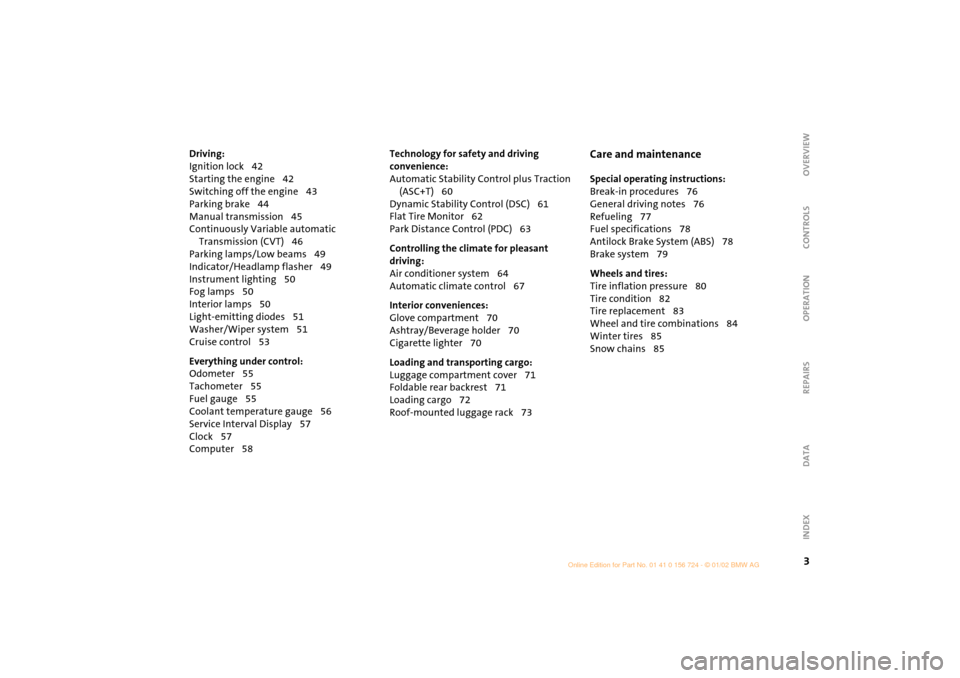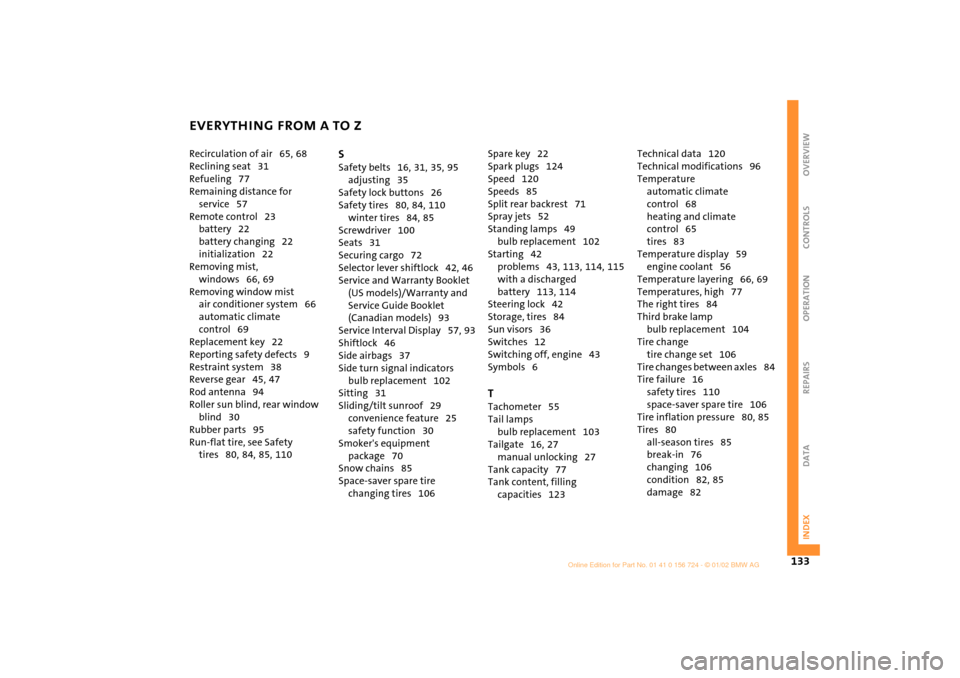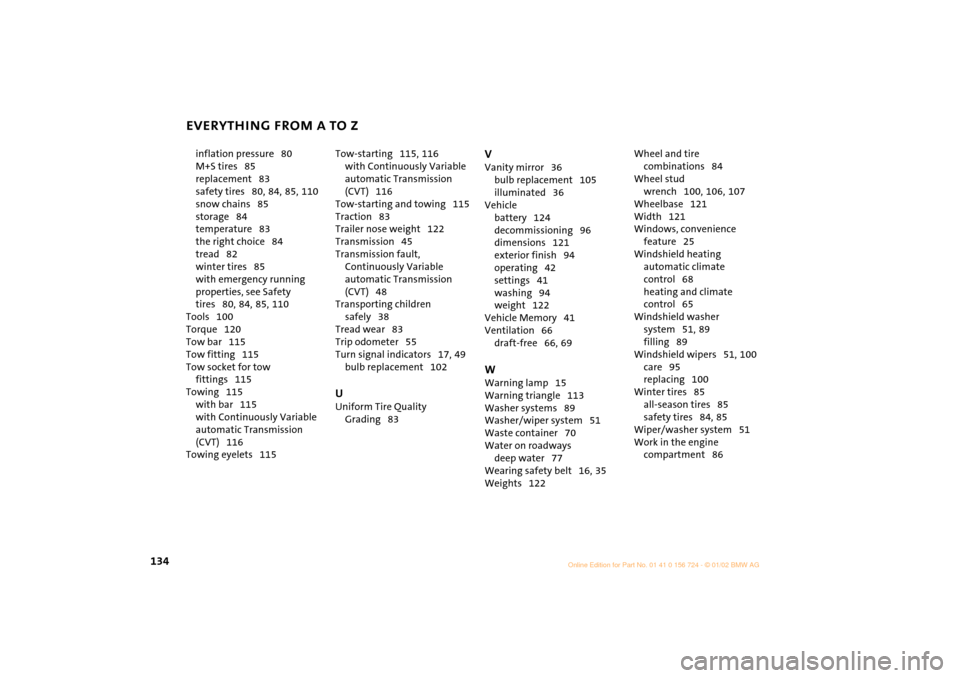snow chains MINI Hardtop 2 Door 2002 Owner's Manual
[x] Cancel search | Manufacturer: MINI, Model Year: 2002, Model line: Hardtop 2 Door, Model: MINI Hardtop 2 Door 2002Pages: 140, PDF Size: 1.63 MB
Page 5 of 140

3
OVERVIEW REPAIRS OPERATION CONTROLS DATA INDEX
Driving:
Ignition lock 42
Starting the engine 42
Switching off the engine 43
Parking brake 44
Manual transmission 45
Continuously Variable automatic
Transmission (CVT) 46
Parking lamps/Low beams 49
Indicator/Headlamp flasher 49
Instrument lighting 50
Fog lamps 50
Interior lamps 50
Light-emitting diodes 51
Washer/Wiper system 51
Cruise control 53
Everything under control:
Odometer 55
Tachometer 55
Fuel gauge 55
Coolant temperature gauge 56
Service Interval Display 57
Clock 57
Computer 58
Technology for safety and driving
convenience:
Automatic Stability Control plus Traction
(ASC+T) 60
Dynamic Stability Control (DSC) 61
Flat Tire Monitor 62
Park Distance Control (PDC) 63
Controlling the climate for pleasant
driving:
Air conditioner system 64
Automatic climate control 67
Interior conveniences:
Glove compartment 70
Ashtray/Beverage holder 70
Cigarette lighter 70
Loading and transporting cargo:
Luggage compartment cover 71
Foldable rear backrest 71
Loading cargo 72
Roof-mounted luggage rack 73
Care and maintenance
Special operating instructions:
Break-in procedures 76
General driving notes 76
Refueling 77
Fuel specifications 78
Antilock Brake System (ABS) 78
Brake system 79
Wheels and tires:
Tire inflation pressure 80
Tire condition 82
Tire replacement 83
Wheel and tire combinations 84
Winter tires 85
Snow chains 85
Page 62 of 140

60
AUTOMATIC STABILITY CONTROL PLUS TRACTION (ASC+T)
*
The concept
This system optimizes vehicle stability and
traction, especially when just starting off,
when accelerating or when cornering.
ASC+T recognizes the danger present in
traction loss and will increase driving
stability and traction by reducing the
engine's output, and if necessary, by
applying the brakes to the front wheels.
ASC+T is operational each time you start
the engine.
The laws of physics cannot be
repealed, even with ASC+T. An appro-
priate driving style always remains the
responsibility of the driver. Avoid using the
additional safety margin provided by the
system as an excuse for taking unnecessary
risks.
Do not make any modifications to the
ASC+T system. Allow only authorized tech-
nicians to perform service procedures on
the ASC+T.<
Switch off the ASC+TBriefly press the switch.
The indicator lamp stays lit.
When driving with snow chains or to "rock
free" in snow, it can be helpful to switch off
the ASC+T for a brief period.
To maintain vehicle stability, always
drive with the ASC+T switched on
whenever possible.
Indicator lamp
The indicator lamp on the instru-
ment cluster will go out shortly
after the ignition has been
switched on, see pages 16, 17.
If the indicator lamp flashes:
ASC+T controls the drive and braking
forces.
If the indicator lamp fails to go out
after the engine is started, or if it
comes on during normal driving and stays
on:
If the system is either defective or was
switched off with the button, then the
stabilizing applications described are no
longer available. You can, however, drive
the vehicle normally without ASC+T.
In the event of a malfunction, please see
your MINI center, see pages 16, 17.<
Page 63 of 140

61
OVERVIEW REPAIRS OPERATIONCONTROLS DATA INDEX
DYNAMIC STABILITY CONTROL (DSC)
*
The concept
This system maintains driving stability
even in critical driving situations.
The system optimizes vehicle stability
during acceleration and when starting
from a full stop, as well as optimizing trac-
tion. In addition, it recognizes unstable
vehicle conditions, such as under- or over-
steering, and, as far as is possible within
the laws of physics, helps keeping the
vehicle on a steady course by reducing the
rpms and brake applications to the indi-
vidual wheels.
The DSC is operational every time you start
the engine. DSC contains the functions
Antilock Brake System ABS/Electronic Brake
Force Distribution EBV/ASC+T.
The laws of physics cannot be
repealed, even with DSC. An appro-
priate driving style always remains the
responsibility of the driver. We therefore
urge you to avoid using the additional
safety margin of the system as an excuse
for taking risks.
Do not make any modifications to the DSC
system. Allow only authorized technicians
to perform service procedures on the
DSC.<
To switch off the DSCBriefly press the switch.
The indicator lamp stays lit.
When driving with snow chains, it may be
effective to switch off the DSC for a brief
period.
To maintain stability, always drive
with the DSC switched on whenever
possible.
Indicator lamp
The indicator lamp on the instru-
ment cluster will go out shortly
after the ignition has been
switched on, see pages 16, 17.
If the indicator lamp flashes:
DSC controls the drive and braking forces.
If the indicator lamp fails to go out
after the engine is started, or if it
comes on during normal driving and stays
on:
If the system is either defective or was
switched off with the button, then the
stabilizing applications described are no
longer available. The vehicle will remain
completely operational, however, without
DSC.
In the event of a malfunction, please see
your MINI center, see pages 16, 17.<
Page 65 of 140

63
OVERVIEW REPAIRS OPERATIONCONTROLS DATA INDEX
FLAT TIRE MONITOR PARK DISTANCE CONTROL (PDC)*
Do not initialize the system when
snow chains are fitted. When driving
with snow chains, false alarms can occur or
pressure losses might not be detected.<
In the following situations false
alarms can also occur under certain
circumstances or the detection of inflation
pressure loss can be delayed:
>When driving on roads covered with
snow or on other slippery road surfaces
>A sporty driving style (slip at the driven
wheels, high lateral accelerations).<
The conceptThe PDC assists you when you back into a
parking space. A signal warns you of the
distance to an obstacle. To do this, four
ultrasonic sensors in the rear bumper
measure the distance to the nearest object.
The range for the sensors located at both
rear corners ends approx. 2 ft (60 cm)
behind the bumpers. The range for the two
middle sensors is slightly less than 5 ft
(1.5 meters).
The system starts to operate automatically
about one second after you select reverse
with the ignition key in position 2. PDC is
deactivated when you shift back out of
reverse. Acoustical signalsThe distance to the nearest object is indi-
cated by a tone sounding at various inter-
vals. As the distance between vehicle and
object decreases, the intervals between the
tones become shorter. A continuous tone
indicates the presence of an object less
than 9 in (20 cm) away.
The warning signal is canceled after
approx. three seconds if the distance to the
obstacle remains constant during this time
(if you are moving parallel to a wall, for
instance).System malfunctions will be indicated by
a continuous high-pitched tone when the
system is activated the first time. Please
have your MINI center resolve the problem.
Even with PDC, final responsibility for
estimating the distance between the
vehicle and any obstructions always
remains with the driver. Even when sensors
are involved, there is a blind spot in which
objects cannot be detected. Moreover, the
detection of obstructions can approach the
physical limits of ultrasonic measurement,
as occurs e. g. in the case of thin and
wedge-shaped objects.
Certain sources of sound, such as a loud
radio, could drown out the PDC signal
tone.<
Keep the sensors clean and free of ice
or snow in order to ensure that they
will continue to operate effectively.
Do not apply high pressure spray to the
sensors for a prolonged period of time.
Always maintain a distance of more than
4 in (10 cm).<
Page 87 of 140

85
OVERVIEW REPAIRSOPERATIONCONTROLS DATA INDEX
WINTER TIRESSNOW CHAINS
*
Choosing the right tire
The manufacturer recommends winter
tires (M+S radial tires) for driving in adverse
winter road conditions. While so-called all-
season tires (M+S designation) provide
better winter traction than summer tires
with the load ratings S, T, H, V, W, they do
not achieve the performance of winter
tires.
In the interest of safe tracking and steering
response, install winter tires made by the
same manufacturer having the same tread
configuration on all four wheels.
Before purchasing winter tires, check
whether your MINI is fitted with safety
tires. You will recognize safety tires by a
circular symbol containing the letters RSC
on the side of the tire, see page 110. In this
case, use only safety tires, as in the event of
a flat tire there is no space-saver spare tire.
Only winter tires recommended by the
manufacturer of your MINI should be
fitted. Any MINI center will be glad to
advise you on the selection of the right
winter tires for the relevant operating
conditions.
Observing speeds
Never exceed the maximum speed
for which the tires are rated.
Unprofessional attempts by laymen to
service tires can lead to damage and acci-
dents.
Have this work performed by skilled profes-
sionals only. Your MINI center will be glad
to assist you with both their expertise and
the proper equipment for your vehicle.<
Tire condition, tire inflation pressure
Once the tire wears to below 0.16 in
(4 mm), winter tires display a percep-
tible decrease in their ability to cope with
winter driving conditions, and should be
replaced in the interest of safety.<
Comply with the specified tire inflation
pressures and be sure to have the wheel
and tire assemblies balanced every time
you change the tires.
The use of narrow-link snow chains is
permitted in pairs only and only on
the front wheels with the following tires:
175/65 R 15
175/60 R 16
When fitting, comply with the manufac-
turer's instructions.<
With chains, do not exceed a speed
of 30 mph (50 km/h).<
After fitting the snow chains, do not
activate the Flat Tire Monitor.
When driving with snow chains, it can be
helpful to switch off the ASC+T or DSC for
a brief period, see pages 60, 61.<
Page 135 of 140

EVERYTHING FROM A TO Z
133
OVERVIEW REPAIRS OPERATION CONTROLS DATA INDEX
Recirculation of air 65,
68
Reclining seat 31
Refueling 77
Remaining distance for
service 57
Remote control 23
battery 22
battery changing 22
initialization 22
Removing mist,
windows 66,
69
Removing window mist
air conditioner system 66
automatic climate
control 69
Replacement key 22
Reporting safety defects 9
Restraint system 38
Reverse gear 45, 47
Rod antenna 94
Roller sun blind, rear window
blind 30
Rubber parts 95
Run-flat tire, see Safety
tires 80,
84,
85,
110
S
Safety belts 16,
31,
35,
95
adjusting 35
Safety lock buttons 26
Safety tires 80,
84,
110
winter tires 84, 85
Screwdriver 100
Seats 31
Securing cargo 72
Selector lever shiftlock 42,
46
Service and Warranty Booklet
(US models)/Warranty and
Service Guide Booklet
(Canadian models) 93
Service Interval Display 57, 93
Shiftlock 46
Side airbags 37
Side turn signal indicators
bulb replacement 102
Sitting 31
Sliding/tilt sunroof 29
convenience feature 25
safety function 30
Smoker's equipment
package 70
Snow chains 85
Space-saver spare tire
changing tires 106 Spare key 22
Spark plugs 124
Speed 120
Speeds 85
Split rear backrest 71
Spray jets 52
Standing lamps 49
bulb replacement 102
Starting 42
problems 43,
113,
114,
115
with a discharged
battery 113,
114
Steering lock 42
Storage, tires 84
Sun visors 36
Switches 12
Switching off, engine 43
Symbols 6
T
Tachometer 55
Tail lamps
bulb replacement 103
Tailgate 16,
27
manual unlocking 27
Tank capacity 77
Tank content, filling
capacities 123 Technical data 120
Technical modifications 96
Temperature
automatic climate
control 68
heating and climate
control 65
tires 83
Temperature display 59
engine coolant 56
Temperature layering 66,
69
Temperatures, high 77
The right tires 84
Third brake lamp
bulb replacement 104
Tire change
tire change set 106
Tire changes between axles 84
Tire failure 16
safety tires 110
space-saver spare tire 106
Tire inflation pressure 80, 85
Tires 80
all-season tires 85
break-in 76
changing 106
condition 82,
85
damage 82
Page 136 of 140

EVERYTHING FROM A TO Z
134
inflation pressure 80
M+S tires 85
replacement 83
safety tires 80,
84,
85,
110
snow chains 85
storage 84
temperature 83
the right choice 84
tread 82
winter tires 85
with emergency running
properties, see Safety
tires 80,
84,
85,
110
Tools 100
Torque 120
Tow bar 115
Tow fitting 115
Tow socket for tow
fittings 115
Towing 115
with bar 115
with Continuously Variable
automatic Transmission
(CVT) 116
Towing eyelets 115 Tow-starting 115,
116
with Continuously Variable
automatic Transmission
(CVT) 116
Tow-starting and towing 115
Traction 83
Trailer nose weight 122
Transmission 45
Transmission fault,
Continuously Variable
automatic Transmission
(CVT) 48
Transporting children
safely 38
Tread wear 83
Trip odometer 55
Turn signal indicators 17,
49
bulb replacement 102
U
Uniform Tire Quality
Grading 83
V
Vanity mirror 36
bulb replacement 105
illuminated 36
Vehicle
battery 124
decommissioning 96
dimensions 121
exterior finish 94
operating 42
settings 41
washing 94
weight 122
Vehicle Memory 41
Ventilation 66
draft-free 66,
69
W
Warning lamp 15
Warning triangle 113
Washer systems 89
Washer/wiper system 51
Waste container 70
Water on roadways
deep water 77
Wearing safety belt 16,
35
Weights 122 Wheel and tire
combinations 84
Wheel stud
wrench 100,
106,
107
Wheelbase 121
Width 121
Windows, convenience
feature 25
Windshield heating
automatic climate
control 68
heating and climate
control 65
Windshield washer
system 51,
89
filling 89
Windshield wipers 51,
100
care 95
replacing 100
Winter tires 85
all-season tires 85
safety tires 84,
85
Wiper/washer system 51
Work in the engine
compartment 86